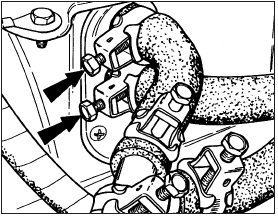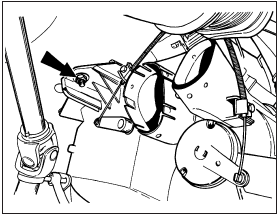Heater - removal and refitting
Removal
1 Disconnect the battery negative lead.
2 Refer to Chapter 11 and remove the centre console.
3 Working within the engine compartment, disconnect the coolant hoses from the heater pipe stubs at the rear bulkhead (see illustration). Raise the ends of the hoses to minimise loss of coolant.

11.3 Coolant hose connections at heater pipe stubs
4 The heater matrix will still contain coolant and should be drained by blowing into the upper heater pipe stub and catching the coolant which will be ejected from the lower one.
5 Remove the cover plate and gasket from around the heater pipe stubs. This is held to the bulkhead by two self-tapping screws.
6 Working inside the vehicle, remove the dash lower trim panels from both sides. The panels are held in position by clips and tags.
7 Pull the air distribution ducts from the heater casing and swivel them as necessary to clear the control cables.
8 Disconnect the control cables from the heater casing and the flap arms.
9 Remove the two heater mounting nuts and lift the heater assembly out of the vehicle, taking care not to spill any remaining coolant on the carpet (see illustration).

11.9 Heater mounting nut location - lefthand side
Refitting 10 Refitting is a reversal of removal. Check that the heater casing seal to the cowl is in good order, otherwise renew it. Adjust the heater controls on completion as described in Section 9.
11 Top-up the cooling system (see “Weekly checks”) and reconnect the battery.
See also:
Exterior lamps - removal and refitting
Headlamp
Removal
1 On pre-1986 models, remove the radiator
grille as described in Chapter 11.
2 Working in the engine compartment,
disconnect the headlamp wiring multi-plug
and remove the sidela ...
Starter motor - testing in the vehicle
1 If the starter motor fails to operate first
check the condition of the battery.
2 Check the security and condition of all
relevant wiring.
Solenoid check
3 Disconnect the battery negative lead ...
Crankshaft and main bearings - removal and refitting
1.8 litre (R2A type)
Removal
1 With the engine removed from the vehicle,
remove the timing belt, crankshaft sprocket
and thrustwasher.
2 Remove the pistons and connecting rods. If
no work is to ...
